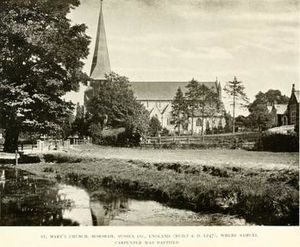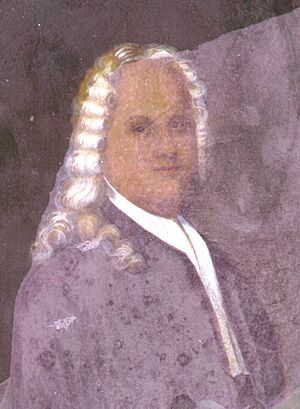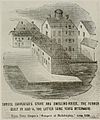Samuel Carpenter facts for kids
Quick facts for kids
Samuel Carpenter
|
|
|---|---|

Samuel Carpenter (1649-1714)
|
|
| Born | 4 November 1649 |
| Died | 10 April 1714 (aged 64) |
| Resting place | Arch Street (Quakers) Burial Ground, Fourth and Arch Streets, Philadelphia, Pennsylvania. |
| Nationality | British |
| Occupation | Merchant |
| Years active | 1671–1714 |
| Known for | Deputy Governor of Philadelphia, First Treasurer of Pennsylvania |
| Spouse(s) | Hannah Hardiman |
| Parent(s) | John Carpenter, of Horsham & Sarah |
Samuel Carpenter (born November 4, 1649 – died April 10, 1714) was an important leader in colonial Pennsylvania. He served as a Deputy Governor and was known as the "First Treasurer" of Pennsylvania. Samuel was a close friend and business partner of William Penn, who founded Pennsylvania. He signed a key document called "The Declaration of Fealty, Christian Belief and Test" in 1695.
Contents
Samuel Carpenter's Early Life and Faith
Samuel Carpenter was born in Horsham, Sussex, England. He was baptized at St. Mary's Church in Horsham in December 1649. His father, John Carpenter, was the Sheriff of Horsham.
When Samuel was 21, his father was murdered. This event made Samuel think deeply about his life. Around this time, he became a follower of the Quaker faith. Quakers believe in peace and simple living.
Samuel left England around 1673 and moved to Barbados. Many of his family members stayed in England and remained part of the Church of England. However, his half-brothers, Abraham and Joshua, later moved to Philadelphia. They became successful citizens there.
Life as a Quaker in Barbados
In Barbados, Samuel joined a group of Quakers. He faced challenges because of his faith. In 1673, he was fined a large amount of sugar for not joining the military. Quakers refused military service because of their peaceful beliefs. They also refused to pay taxes that supported the official church.
The island's slave owners made laws against Quakers preaching Christianity to enslaved people. This led to many Quakers leaving Barbados by 1683. Samuel was fined again in 1683 for not providing men for military service. This fine was dropped when he decided to leave the island.
Samuel and other Quakers decided to move to Pennsylvania. William Penn had invited people of all faiths to come and worship freely there.
Moving to Philadelphia and Family Life
Samuel arrived in Philadelphia around July 10, 1683. He was wealthy from selling his property in Barbados and from his inheritance. He used his money to invest in land, mines, mills, and docks in the new colony.
In 1684, Samuel Carpenter married Hannah Hardiman in Philadelphia. Hannah was known for her intelligence and influence among the Quakers. Their marriage certificate is one of the oldest in Philadelphia. They had six children together.
- Hannah Carpenter (born 1685/1686 – died 1728) married William Fishbourne, who later became the Mayor of Philadelphia.
- Samuel Carpenter (2nd) (born 1687/1688 – died 1748) was a merchant and a Justice of the Peace.
- Joshua Carpenter (born 1689 – died 1689) died as a baby.
- John Carpenter (born 1690 – died 1724) was a member of the Philadelphia Common Council.
- Rebecca Carpenter (born 1692 – died 1713) never married.
- Abraham Carpenter (born 1694 – died 1702) died as a young boy.
Most of Samuel's family members are buried at the Quakers Burial Ground in Philadelphia.
Samuel's Notable Half-Brothers
Samuel had two half-brothers, Joshua and Abraham, who also came to Philadelphia in 1683. They were born to different mothers but remained close to Samuel.
Joshua Carpenter (born 1638 – died 1722) was a successful brewer. His "Philadelphia Ale" was very famous. He was also one of the people who helped start Christ Church in Philadelphia. He later moved to Delaware.
Abraham Carpenter (born 1652 – died 1708) was a merchant. He also helped build Christ Church in Philadelphia. He traveled back to England often to help set up trade between Philadelphia and English mills. This helped Philadelphia's economy grow.
Carpenter's Wharf and Important Buildings
Samuel Carpenter bought a large piece of land in Philadelphia. It stretched from King Street (now Water Street) to Front Street and then to Second Street. On the side facing the Delaware River, he built the first dock in Philadelphia. This dock became known as "Carpenter's Wharf." It was big enough for large ships to use. Over the years, many warehouses and other buildings were built around it. Today, this area is covered by Interstate 95 near Penn's Landing.
Near his wharf, Samuel built one of the first brick mansions for his family. This house faced the Delaware River but was taken down by 1830.
In 1687, Samuel Carpenter built the famous "Slate Roof House" on Second Street. This was the first house of its kind in the city. Many important people in Philadelphia's history lived there. The mansion stood until 1867.
In 1686, Samuel and his brother Joshua opened the Tun Tavern brewhouse at Carpenter's Wharf. This place is famous because it's traditionally where the United States Marine Corps first started recruiting members.
Samuel's Roles in the Colony
Samuel Carpenter held many important positions in the government of Pennsylvania:
- He was a member of the Governor's Provincial Council from 1686 to 1713.
- He served as the First Treasurer of Pennsylvania from 1704 to 1713.
- He was a member of the Assembly in 1693–1694, 1696, and 1705.
Deputy Governor of Pennsylvania (1694-1698)
Samuel Carpenter served as the Deputy for Governor William Penn. Penn, who was the "Proprietor" (owner) of Pennsylvania, was often in England. So, Samuel Carpenter was in charge of the daily operations of the colony. He served as Deputy Governor from 1694 to 1698.
Many people believed that Samuel Carpenter was the wealthiest and most influential person in the colony, second only to William Penn himself. He was a strong Quaker and was very helpful to Penn when Penn was away.
Financial Challenges and Recovery
Around 1702, Philadelphia faced financial difficulties due to pirates and wars. Trade suffered, and Samuel Carpenter, like many others, lost money. He had to sell some of his properties.
However, by 1709, trade improved, and profits went up. By the time Samuel Carpenter died in 1714, he had paid off almost all his debts. This meant his family was left in a good financial position.
A Supporter of Philadelphia's Growth
Samuel Carpenter was not just a businessman; he was also a philanthropist. This means he gave money and time to help public projects in Philadelphia. Many old records show how generous he was and how much he helped build the city.
One example of his involvement is a weather vane from an old mill. This weather vane had the initials of the original partners who rebuilt the mill: William Penn, Samuel Carpenter, and Caleb Pusey. This historical item is now kept at the Atwater Kent Museum of Philadelphia.
Death and Legacy
Samuel Carpenter passed away on April 10, 1714, at his son-in-law's home in Philadelphia. His friend, James Logan, wrote a letter to William Penn saying that Samuel died peacefully. Logan described him as a man of "sincere honesty and public spirit" who was "universally beloved and esteemed."
The Quaker meeting, after his death, praised him as a "pattern of humility, patience and self denial." They said he was a loving husband, a caring father, and a loyal friend.
Samuel Carpenter was buried at the Quakers Burial Ground in Philadelphia. He left behind many descendants who became important figures in Philadelphia and Pennsylvania. Many leading families in Philadelphia can trace their family history back to Samuel Carpenter.
Images for kids
-
The story of the Weather Vane from the Samuel Carpenter 1912 book by General Louis H. Carpenter.









